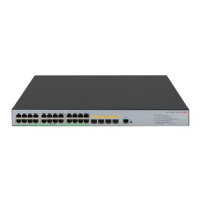183
If the DR fails, a new DR election process will start after the DR is aged out. However, it might take a long
period of time. To start a new DR election process immediately after the original DR fails, enable PIM to
work with Bidirectional Forwarding Detection (BFD) on a multi-access network to detect failures of the
links among PIM neighbors. You must enable PIM to work with BFD on all PIM-capable routers on a
multi-access network, so that the PIM neighbors can fast detect DR failures and start a new DR election
process.
For more information about BFD, see High Availability Configuration Guide.
Before you configure this feature on an interface, be sure to enable PIM-DM or PIM-SM on the interface.
To enable PIM to work with BFD:
Ste
Command
Remarks
1. Enter system view.
system-view N/A
2. Enter interface view.
interface interface-type interface-number N/A
3. Enable PIM to work
with BFD.
pim bfd enable Disabled by default
Setting the DSCP value for PIM messages
IPv4 uses an eight-bit ToS field to identify type of service for IP packets. As defined in RFC 2474, the first
six bits contains the DSCP priority for prioritizing traffic in the network and the last two bits are reserved.
To set the DSCP value for PIM messages:
Ste
Command
Remarks
1. Enter system view.
system-view N/A
2. Enter public network IGMP
view or VPN instance PIM
view.
pim [ vpn-instance
vpn-instance-name ]
N/A
3. Set the DSCP value for PIM
messages
dscp dscp-value
Optional.
By default, the DSCP value in PIM
messages is 48.
Displaying and maintaining PIM
Task Command Remarks
Display the BSR information in the
PIM-SM domain and locally
configured C-RP information in
effect.
display pim [ all-instance |
vpn-instance vpn-instance-name ]
bsr-info [ | { begin | exclude |
include } regular-expression ]
Available in any view

